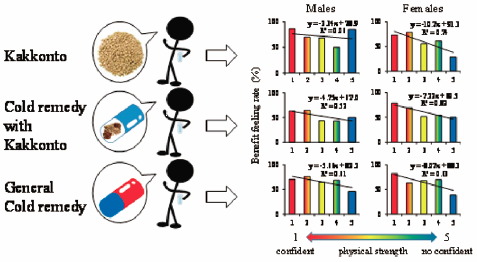- 著者
- Mitsuyoshi Okita Yuki Yayoshi Kousuke Ohara Akio Negishi Hayato Akimoto Naoko Inoue Sachihiko Numajiri Shigeru Ohshima Seiichi Honma Shinji Oshima Daisuke Kobayashi
- 出版者
- The Pharmaceutical Society of Japan
- 雑誌
- Biological and Pharmaceutical Bulletin (ISSN:09186158)
- 巻号頁・発行日
- vol.40, no.10, pp.1730-1738, 2017-10-01 (Released:2017-10-01)
- 参考文献数
- 21
- 被引用文献数
- 3
Kakkonto (KK), a traditional Japanese Kampo formulation for cold and flu, is generally sold as an OTC pharmaceuticals used for self-medication. Kampo formulations should be used according to the Sho-symptoms of Kampo medicine. These symptoms refer to the subjective symptoms themselves. Although with OTC pharmaceuticals, this is often not the case. We surveyed the relationship of agreement of Sho with the benefit feeling rate (BFR) of patients who took KK (n=555), cold remedies with KK (CK, n=315), and general cold remedies (GC, n=539) using internet research. BFR of a faster recovery was greater in participants who took the medication early and who had confidence in their physical strength in all treatment groups. BFR was significantly higher in the GC group than in the KK group for patients with headache, runny nose, blocked nose, sneezing, and cough. BFR was also significantly higher in the GC group than in the CK group for headache (males) and cough (females). BFR was the highest in the KK group for stiff shoulders. All cold remedies were more effective when taken early, and the larger the number of Sho that a patient had, the greater the BFR increased. Therefore, a cold remedy is expected to be most effective when there are many cold symptoms and when it is taken at an early stage of the common cold.
- 著者
- Shinji Oshima Kazuhiko Senoo Akio Negishi Hayato Akimoto Kousuke Ohara Naoko Inoue Shigeru Ohshima Nobuaki Kutsuma Kazuhiko Juni Daisuke Kobayashi
- 出版者
- The Pharmaceutical Society of Japan
- 雑誌
- Biological and Pharmaceutical Bulletin (ISSN:09186158)
- 巻号頁・発行日
- vol.39, no.3, pp.313-322, 2016-03-01 (Released:2016-03-01)
- 参考文献数
- 20
- 被引用文献数
- 2 6
Article 25-2 of the Japanese Pharmacists’ Act was revised in June 2014, establishing the position of pharmacists as “advisors on the use of pharmaceuticals.” Prior to the Act’s revision, we investigated the perceptions of patients and pharmacists about pharmacists’ roles using a social science methodology. We also examined current opinions and necessary factors for the future growth and development of pharmacists. This questionnaire survey was conducted using an internet method. Patients and pharmacists answered 12 questions. Responses from 529 patients and 338 pharmacists were analyzed. For all items, pharmacists’ awareness of their roles exceeded patients’ awareness of the roles. In this study, the difference between pharmacist and patient awareness was larger than in similar research conducted in the United States. The greatest difference was observed in three items: “Understanding the effects of the drugs the patients are taking” (rate of high ratings: pharmacists 80.2%, patients 37.8%), “Understanding the health changes caused by the drugs dispensed to the patients” (pharmacists 80.2%, patients 28.4%), and “Consciously protecting patients from the adverse effects of drugs” (pharmacists 82.8%, patients 42.2%), indicating role discrepancy. Partition analysis indicated the three factors for a pharmacist to be regarded as a drug therapy or medication specialist: “The patient regards the pharmacist as his/her family or regular pharmacist,” “The pharmacist is making it easy for a patient to talk with him/her” and “The pharmacist is aware of a patient’s use of products other than prescribed drugs, such as over the counter (OTC) medications or health foods and nutritional supplements.” Future efforts are necessary to resolve role discrepancy and implement ongoing monitoring.
- 著者
- Mitsuyoshi Okita Yuki Yayoshi Kousuke Ohara Akio Negishi Hayato Akimoto Naoko Inoue Sachihiko Numajiri Shigeru Ohshima Seiichi Honma Shinji Oshima Daisuke Kobayashi
- 出版者
- 公益社団法人日本薬学会
- 雑誌
- Biological and Pharmaceutical Bulletin (ISSN:09186158)
- 巻号頁・発行日
- pp.b17-00340, (Released:2017-08-04)
- 参考文献数
- 21
- 被引用文献数
- 3
Kakkonto (KK), a traditional Japanese Kampo formulation for cold and flu, is generally sold as an over-the-counter (OTC) pharmaceuticals used for self-medication. Kampo formulations should be used according to the Sho-symptoms of Kampo medicine. These symptoms refer to the subjective symptoms themselves. Although with OTC pharmaceuticals, this is often not the case. We surveyed the relationship of agreement of Sho with the benefit feeling rate (BFR) of patients who took KK (n = 555), cold remedies with KK (CK, n = 315), and general cold remedies (GC, n = 539) using internet research. BFR of a faster recovery was greater in participants who took the medication early and who had confidence in their physical strength in all treatment groups. BFR was significantly higher in the GC group than in the KK group for patients with headache, runny nose, blocked nose, sneezing, and cough. BFR was also significantly higher in the GC group than in the CK group for headache (males) and cough (females). BFR was the highest in the KK group for stiff shoulders. All cold remedies were more effective when taken early, and the larger the number of Sho that a patient had, the greater the BFR increased. Therefore, a cold remedy is expected to be most effective when there are many cold symptoms and when it is taken at an early stage of the common cold.

